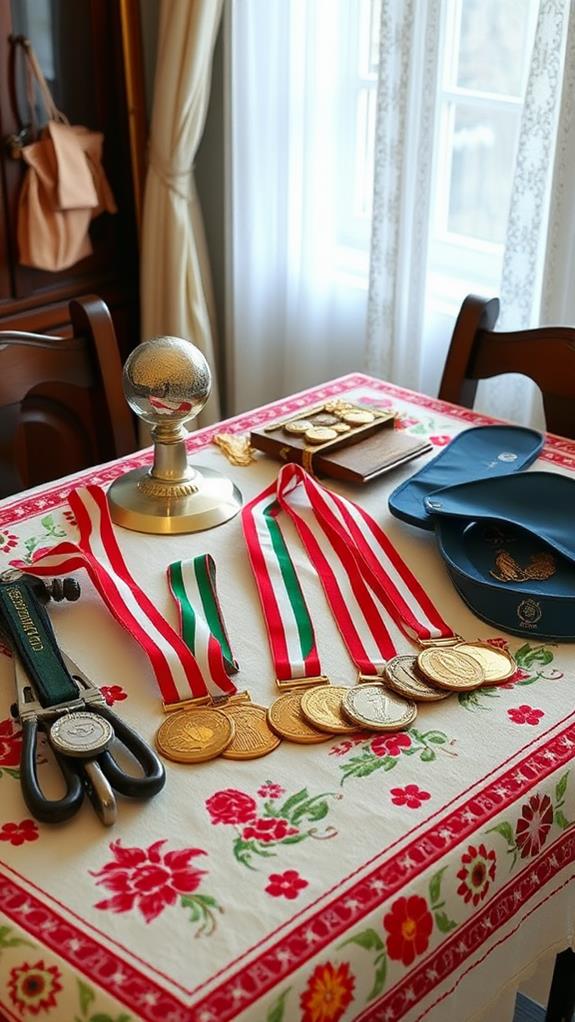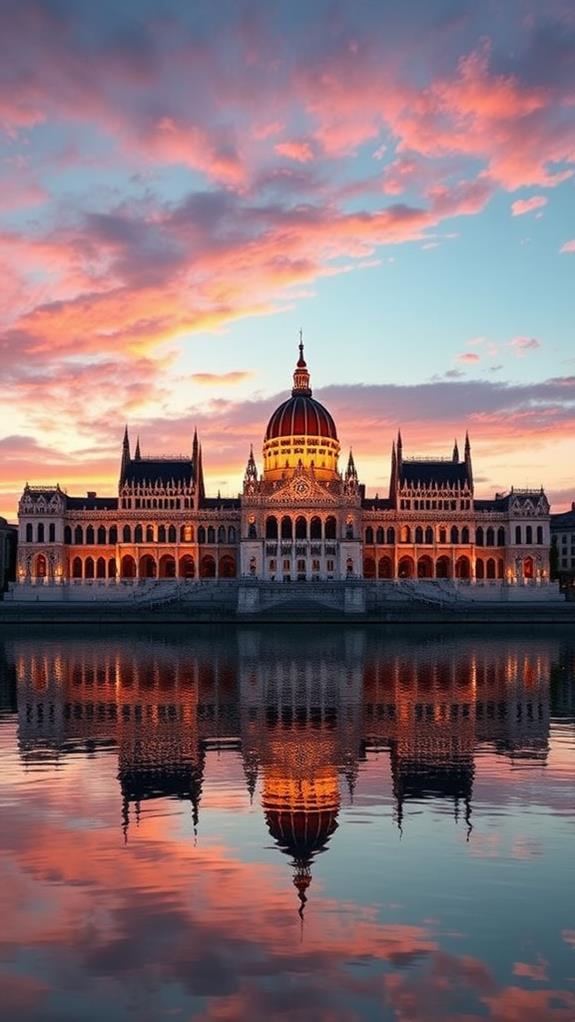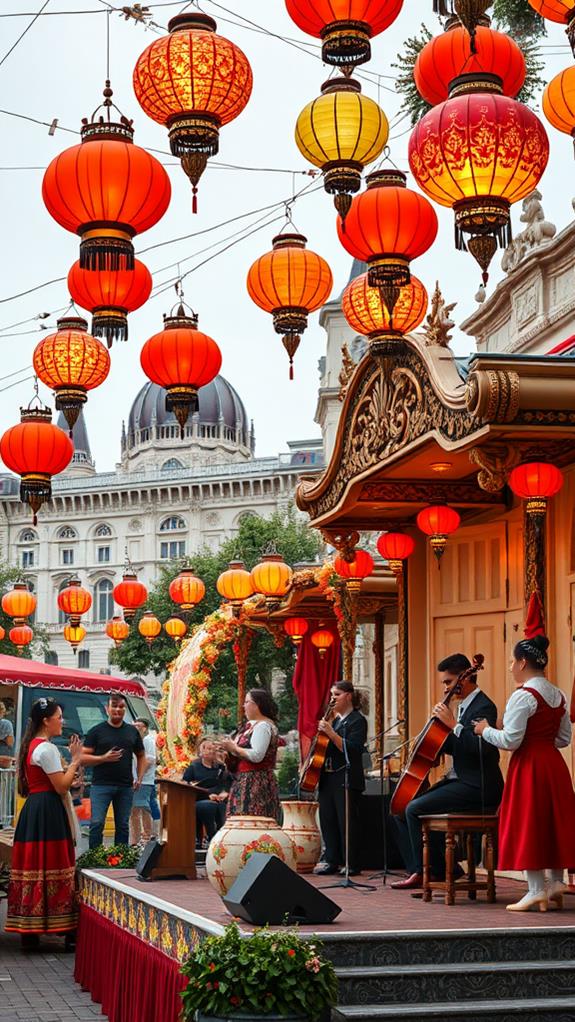Interesting Facts About Hungary You Never Knew
Did you know that Hungary is a linguistic island in Europe? Its language, Magyar, isn't related to its neighbors' tongues. You'll find over 1,300 thermal springs here, with 123 in Budapest alone. Hungary's given the world 13 Nobel Prize winners and inventions like the Rubik's Cube and ballpoint pen. It's an Olympic powerhouse, especially in water polo. Budapest's architecture will wow you, from the Gothic Revival Parliament to the iconic Chain Bridge. Hungarian cuisine revolves around paprika, and the country boasts the world's first official wine region. There's much more to uncover about this Central European gem.
This post may contain affiliate links. If you make a purchase through these links, I may earn a commission at no additional cost to you. Additionally, portions of this post may be generated using artificial intelligence (AI) technology. While we strive for accuracy, please be aware that AI-generated content may not always be perfect and should be fact-checked when necessary.
The Spatula Scoops
- Hungarian is the only official language in the EU not belonging to the Indo-European language family.
- Budapest hosts over 120 thermal springs, making it a global leader in spa culture.
- The Rubik's Cube, ballpoint pen, and Ford Model T were all invented by Hungarians.
- Hungary has won 175 Olympic gold medals, an impressive feat for its population size.
- The world's first official wine region, Tokaj, was established in Hungary in 1737.
Hungary's Linguistic Uniqueness

While many European languages share common roots, Hungarian stands out as a linguistic anomaly. Known as Magyar, it's part of the Finno-Ugric language family, making it distinct from the Indo-European languages that dominate the continent. You'll find that Hungarian is often cited as one of Europe's most complex languages, with an intricate grammar system that can challenge even the most adept language learners.
One of the most striking features of Hungarian is its extensive case system, with up to 18 cases that modify word forms based on context. This complexity extends to its vocabulary, which includes many unique words that can perplex native speakers. If you're interested in the language's history, you'll discover that its origins trace back to Central Asia, with the earliest written records appearing in the 10th century.
Hungarian's phonetic complexity adds another layer of difficulty for learners. The language incorporates various sounds, including vowels with diacritical marks, which contribute to its distinct pronunciation. As you explore Hungarian, you'll encounter a linguistic landscape that's both fascinating and challenging, reflecting Hungary's unique cultural heritage.
Thermal Springs and Spa Culture

You'd be hard-pressed to find a country more devoted to thermal springs than Hungary. With over 1,300 thermal water springs scattered across the nation, including 123 in Budapest alone, Hungary's spa culture is deeply ingrained in its national identity. This abundance of natural resources has been cherished since Roman times, offering therapeutic benefits that continue to attract wellness tourism today.
When you visit Hungary, you'll encounter a blend of traditional Turkish architecture and modern spa facilities in famous baths like Széchenyi, Rudas, and Gellért. These thermal baths aren't just tourist attractions; they're an integral part of Hungarian life. Locals and visitors alike flock to these healing waters, believed to alleviate various medical conditions.
The communal bathing experience you'll find in Hungary reflects the country's social and cultural ties. It's not uncommon to see people of all ages enjoying the thermal waters together, playing chess, or engaging in animated conversations. This unique aspect of Hungarian culture offers you a chance to immerse yourself in local traditions while reaping the health benefits of these mineral-rich springs.
Nobel Laureates and Scientific Contributions

Hungary's intellectual prowess shines through its impressive roster of Nobel laureates. Since 1905, this small Central European country has produced 13 Nobel Prize winners across various fields, showcasing its considerable contributions to global scientific advancement.
You might be surprised to learn that Hungary's first Nobel Prize in Physics was awarded to Philipp Lenard in 1905 for his groundbreaking work on cathode rays. This early achievement set the stage for future Hungarian scientists to make their mark on the world stage. One such notable figure is Albert Szent-Györgyi, who received the Nobel Prize in Physiology or Medicine in 1937 for his discovery of Vitamin C, revolutionizing our understanding of nutrition.
In the domain of physics, Eugene Wigner's 1963 Nobel Prize for his advancements in nuclear theory greatly influenced quantum mechanics. Hungary's scientific contributions extend beyond the natural sciences, as evidenced by John Harsányi's 1994 Nobel Prize in Economics for his analysis of game theory. This work has considerably shaped economic modeling and decision-making processes. These accomplishments underscore Hungary's enduring legacy in pushing the boundaries of human knowledge across diverse fields.
Hungarian Inventions That Changed History

Beyond scientific achievements, Hungary has left an indelible mark on history through its innovative inventions. You might be surprised to learn that many everyday items were first invented by a Hungarian. Take the Rubik's Cube, for instance. This mind-bending puzzle, created by Ernő Rubik in 1974, has become the world's best-selling toy, with over 350 million sold globally. It's just one of many interesting facts about Hungarian ingenuity.
Another Hungarian invention that revolutionized our daily lives is the ballpoint pen. Invented by Laszlo Biro in 1938, it transformed writing instruments worldwide. In the automotive industry, József Galamb's design of the Ford Model T made car ownership accessible to the masses, changing transportation forever. Miksa Déri's invention of the first practical transformer advanced electricity transmission technologies, shaping our modern power systems. Ultimately, Leo Szilard's co-design of the world's first nuclear reactor in Chicago laid the groundwork for nuclear energy developments. These Hungarian inventions demonstrate the country's significant impact on global technological progress, showcasing its innovative spirit and contribution to modern society.
Olympic Success and Sports Heritage

Olympic glory has been a hallmark of Hungary's sporting legacy for over a century. You might be surprised to learn that this relatively small nation has amassed an impressive 491 Olympic medals, including 175 golds. This remarkable achievement places Hungary among the most successful countries in Olympic history, especially when you consider its population size.
Hungary's prowess in water sports is particularly significant. The Hungarian water polo team stands out as the most dominant in Olympic history, having secured nine gold medals since the sport's introduction to the Games. But Hungary's success isn't limited to the pool. In fencing, Aladár Gerevich holds the record for the most Olympic gold medals, with six victories spanning from 1932 to 1960.
The country's consistent performance across various Olympic disciplines, including gymnastics, showcases its diverse athletic heritage. This success isn't by chance; it's the result of a strong emphasis on sports programs in schools throughout Hungarian history. These programs have played a vital role in nurturing talent and maintaining Hungary's competitive edge in international competitions.
Budapest's Architectural Marvels

As you explore Budapest's architectural wonders, you'll be captivated by the Gothic Revival splendor of the Hungarian Parliament Building. This iconic structure, with its intricate spires and stunning riverside location, stands as a symbol of the city's rich history and architectural prowess. Another marvel you can't miss is the Chain Bridge, an engineering masterpiece that connects Buda and Pest, featuring a distinctive design with stone lion statues guarding its entrances.
Parliament's Gothic Revival Splendor
A jewel in Budapest's architectural crown, the Hungarian Parliament stands as a tribute to Gothic Revival splendor. You'll be amazed by its sheer size, ranking as the world's third-largest parliament building. With 691 rooms and 20 kilometers of stairs, it's a manifestation of architectural grandeur.
Constructed between 1885 and 1904, this magnificent structure showcases the Gothic Revival style in all its glory. As you approach, you'll notice its iconic dome reaching 96 meters high, a deliberate nod to the year 896 when Hungarian tribes settled in the Carpathian Basin. This height also sets the limit for Budapest's skyline.
Inside, you're treated to a visual feast of artistic heritage. Intricate frescoes, stained glass windows, and richly decorated halls await your exploration. The building's crowning glory, quite literally, is the display of Hungary's Crown Jewels in the central dome. This regal exhibit connects you directly to the nation's royal lineage and rich history. As you wander through the Parliament, you'll gain a deeper appreciation for Hungary's cultural and architectural legacy.
Chain Bridge's Iconic Design
Spanning the mighty Danube, Budapest's Chain Bridge stands as a tribute to 19th-century engineering prowess and architectural beauty. You'll be amazed to learn that this iconic structure was the first permanent bridge connecting Buda and Pest, completed in 1849. Designed by English engineer William Tierney Clark, the Chain Bridge showcases a stunning neoclassical style that's become synonymous with Budapest's skyline.
As you approach the bridge, you'll notice impressive lion statues guarding each end, adding to its grandeur. The bridge's dimensions are equally impressive: it stretches 202 meters in length and 14 meters in width. This engineering marvel played a significant role in Budapest's development, enhancing trade and transportation between the two city parts and sparking rapid modernization.
The Chain Bridge has withstood the test of time, undergoing several renovations throughout its history. Most remarkably, it required extensive restoration after sustaining damage during World War II. In 1949, exactly a century after its initial completion, the bridge reopened to the public, reclaiming its place as a symbol of Hungarian resilience and architectural brilliance.
Culinary Traditions and Wine Regions

Hungary's culinary traditions and wine regions offer a feast for the senses. You'll find a rich tapestry of flavors, with iconic dishes like goulash and pörkölt taking center stage. At the heart of Hungarian cuisine lies paprika, the nation's most beloved spice. With over 40 varieties cultivated, it's no wonder the average Hungarian consumes more than 1.10 lbs annually.
But Hungary's gastronomic prowess doesn't stop at food. The Tokaj wine region, recognized as the world's first official wine area in 1737, boasts a winemaking history dating back to the 5th century A.D. You'll encounter the famous Tokaji Aszú, often called the "Wine of Kings, King of Wines," celebrated for its exceptional quality and rich history.
| Culinary Highlights | Wine Specialties |
|---|---|
| Goulash | Tokaji Aszú |
| Pörkölt | Furmint |
| Paprika-infused soups | Hárslevelű |
| Regional specialties | Sárgamuskotály |
| Traditional desserts | Eszencia |
As you explore Hungary's culinary landscape, you'll discover a diverse array of regional specialties, each reflecting unique ingredients and cooking techniques. This rich gastronomic heritage forms an integral part of Hungary's national identity and cultural legacy.
How Do Hungary’s Unique Facts Compare to the Rest of Europe?
Hungary stands out with its rich history, thermal baths, and the world-famous Hungarian language, which is unlike any other in Europe. When exploring european fun facts, Hungary ranks high with its invention of the Rubik’s Cube and unique cultural festivals, showcasing its distinct charm compared to the rest of the continent.
Music and Cultural Festival Scene

You'll find Hungary's music and cultural festival scene to be vibrant and diverse. The Sziget Festival, held annually in Budapest, stands out as one of Europe's largest music events, attracting over 500,000 visitors and featuring an impressive lineup of international artists. If you're interested in a more traditional experience, you can explore Hungary's rich folk music traditions at numerous festivals throughout the country, where performers often don colorful traditional costumes and showcase time-honored dances. For a blend of arts and culture, don't miss the Budapest Spring Festival in March, which offers a wide array of performances across the city, from classical music to contemporary dance.
Sziget Festival Highlights
One of Europe's largest music and cultural extravaganzas, the Sziget Festival, transforms Budapest's Óbuda Island into a vibrant hub of creativity each August. This week-long event attracts over 500,000 visitors from around the globe, offering a staggering array of more than 1,000 performances across various genres, including rock, pop, electronic, and world music.
You'll find yourself immersed in a diverse cultural experience, with art installations, workshops, and performances from international theater, dance, and circus acts. The festival's reputation has earned it recognition from Rolling Stone magazine as one of the world's top music festivals, often featuring headliners like Ed Sheeran, Dua Lipa, and Kendrick Lamar.
As you explore the festival grounds, you'll discover unique amenities that set Sziget apart. Take a dip in the 'magic' swimming pool area, dance the night away at the silent disco stage, or wander through themed villages celebrating different cultures and artistic expressions. With its vast array of performances and cultural offerings, Sziget Festival provides an unparalleled experience that showcases Hungary's vibrant music and arts scene.
Budapest Spring Festival
As winter fades into spring, Budapest bursts into a vibrant celebration of arts and culture with its annual Budapest Spring Festival. You'll find this two-week extravaganza showcasing a diverse range of performances, from classical concerts to contemporary dance shows. With over 200 programs spread across the city, you're in for a treat whether you're a local or a tourist.
The festival highlights Hungary's rich cultural heritage, featuring performances by the Hungarian State Opera and internationally acclaimed artists. You'll have the chance to explore historical venues and modern cultural centers alike, immersing yourself in the city's unique atmosphere.
But it's not just about music. The Budapest Spring Festival also offers literary events, visual art exhibitions, and even gastronomic experiences. This multi-faceted approach guarantees there's something for everyone, reinforcing Budapest's status as a vibrant cultural hub in Europe.
Each year, thousands flock to the city to partake in this cultural feast. So, if you're planning a trip to Hungary, consider timing it with the Budapest Spring Festival. You'll witness firsthand why this event has become a cornerstone of Hungary's cultural calendar.
Folk Music Traditions
While Hungary's cultural scene is diverse, its folk music traditions stand out as a cornerstone of national identity. You'll find that Hungarian folk music is characterized by unique scales and rhythms, often featuring traditional instruments like the violin, tárogató, and cimbalom. These melodies are deeply rooted in historical events and narratives, with lyrics frequently highlighting themes of love, nature, and the rural lifestyle.
If you're interested in experiencing this rich musical heritage firsthand, you'll want to attend one of Hungary's many cultural festivals. The Busó Festival in Mohács and the Folk Music Festival in Sziget are notable events where you can witness vibrant folk dance performances and hear talented musicians. These festivals showcase choreographed dances that reflect regional traditions and storytelling, contributing to the preservation of Hungary's cultural identity.
It's worth noting that many Hungarian folk songs have been passed down orally through generations. To guarantee the continuation of these traditions, initiatives are in place to teach and promote them among younger audiences. By attending these events, you're not just enjoying music; you're participating in the ongoing preservation of Hungary's folk music legacy.
Frequently Asked Questions
What Is Unique to Hungary?
Like a hidden gem in Europe's crown, Hungary boasts unique features you won't find elsewhere. You'll discover the world's first official wine region, Tokaj, recognized in 1737. The Magyar language stands out, belonging to the Finno-Ugric family. You'll ride continental Europe's oldest electrified underground in Budapest. With over 1,300 thermal springs, you're never far from healing waters. Don't miss Europe's largest synagogue in Budapest, a symbol of Hungary's rich cultural tapestry.
What Is Iconic About Hungary?
When you think of Hungary's iconic features, you'll find a rich tapestry of history and innovation. You'll discover the world's first official wine region, Tokaj, and Budapest's Metro Line 1, the second oldest underground rail system globally. You'll marvel at Europe's largest synagogue and relax in the country's numerous thermal springs. Don't forget the Rubik's Cube, a Hungarian invention that's become a global phenomenon. These elements combine to create Hungary's unique cultural and historical identity.
What Is so Special About Hungarian?
You'll find that Hungarian is a linguistic diamond in the rough. It's part of the Finno-Ugric family, setting it apart from most European languages. You'll be fascinated by its unique grammar structure and vowel harmony. Hungary's thermal baths are world-renowned, offering relaxation and health benefits. You can't miss trying the iconic Tokaji Aszú wine or savoring the nation's paprika-infused cuisine. Don't forget to sample pálinka, the traditional fruit brandy that's a staple of Hungarian hospitality.
What Are Some Hungarian Historical Facts?
You'll find Hungary's history rich with fascinating facts. Did you know it's one of Europe's oldest nations, founded in 897? You might be surprised to learn that Hungary was once part of the influential Austro-Hungarian Empire. After World War I, the Treaty of Trianon drastically reduced Hungary's territory. In 1956, Hungarians bravely revolted against Soviet control, though the uprising was ultimately suppressed. Finally, you should note that Hungary shifted to a democratic republic in 1989, ending communist rule.





